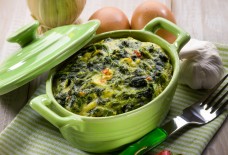The Delightful Eggplant
By Habeeb Salloum/Arab America Contributing Writer
From large round or egg-shaped to small and thin, the attractiveness of the many varieties of eggplants on vegetable shelves has, in this century, been catching the fancy of increasing numbers of consumers and housewives. From black to blue, mauve, purple, white and all the shades in between, eggplants, like magnets, draw the seeker of appealing foods. Barely known in some parts of the world for many years, they are catching on increasingly in the kitchens of almost every country in the world.
On the other hand, for thousands of years, in the lands of their origin, they have been one of the most popular vegetable crops. In China, India, Japan, the Balkans and the countries that border on the eastern Mediterranean, they have been utilized with, or as a meat substitute for untold centuries.
Some historians have suggested that the eggplant originated in China about 4,000 years ago and have been, since 1,500 B.C., grown and eaten as a vegetable in Iran and India. The Arabs introduced them into the Middle East in the 8th century after which their history became well documented.
When, in the 7th century A.D., the Arab armies entered Iran and India they immediately took to this vegetable, and brought it back home under the name, badhinjan, an Arabized form of the Persian badnjan. In the next century, after the Islamic conquest of the Iberian Peninsula, the Arabs introduced this vegetable into Europe.
In the villas and palaces of Muslim Spain, the eggplant, which had been unknown to the Europe of that age, often graced the tables of the Moors. Soon eggplant cultivation spread through the Iberian Peninsula, and in later centuries to the remainder of Europe. The Arabic name of the eggplant adapted to and still carried in many European languages, attests to its introduction by way of the Arabs. The Spanish berenjena, Portuguese berinjela and the French aubergine, are all derived from the Arabic badhinjan. Curiously, even though most European languages adopted the Arabic name, English derived its name from an eggplant species which resembles an egg.
Eggplant and Ground Meat FattehEggplant cultivation only spread gradually into western lands. In many parts of Europe it was near the end of the 16th century before it was widely grown, and then, mostly as a decorative plant. In North America, only in the last few decades has it been cultivated in an appreciable quantity, mainly in the southern U.S.A.
Requiring long warm summers to mature, eggplants thrive best in the tropical parts of the world. They grow from one to two feet high and produce wide grey-green leaves and fruits weighing from a few ounces to over two pounds. In the western world, eggplants are cultivated for both culinary and ornamental purposes. However, in the eastern lands they are raised mostly for their edible fruit.
The nutritional value of this fruit/vegetable is about average perhaps, on the same level as tomatoes. On the other hand, eggplants are not rich in calories, making them ideal for those who must watch their weight. In the Mediterranean countries they are known as ‘the peasant’s meat’ and regarded as a staple. Their meaty texture makes them extremely versatile. It is said that if the eggplant recipes of all the Mediterranean countries were gathered, there would be well over a thousand. In the Arab countries of the Middle East alone, at least 150 eggplant dishes are known.
To this delightful vegetable some Arabs attribute joy or misery in their married lives. A newlywed bride learns quickly to master the art of making succulent eggplant meals. There is an Arab proverb which says: ‘A woman, after marriage, controls her husband with her beauty, then in his middle age by feeding him delicious eggplant stews, and in his old age by beating him with her bathroom clog’.
Meat and eggplant casserole-Shayk al-mahsheeEggplants can be cooked or preserved in various ways. When they are to be puréed, they can be roasted over coals or in the oven. Broiling over open fire gives them a delicate smoky flavour, but baking them in the oven is much easier for a busy housewife. The skin should be pierced in several places before roasting or baking and the eggplants turned a few times as they cook. When the skin blisters, the eggplants are cooked, then the skin should be removed immediately. The resulting light creamy texture of the cooked pulp is appealing and extraordinarily good to eat.
If the eggplant is to be fried or utilized in salads and stews, after slicing or cubing, it should be placed in a strainer, then sprinkled with salt. A weight should then be placed on top and the pieces allowed to-drain for half an hour to remove the bitter juices. When being fried, the eggplant slices or cubes must be fried quickly to cut down on the absorption of the oil or butter.
Eggplant Deep-Baba GhanoujWhen eggplants are to be preserved, besides pickling ingredients, oil is utilized. This gives the pickles a smooth rich taste. Experience through the centuries has demonstrated that oil is the perfect medium to use when cooking or preserving eggplants.
Keeping these hints in mind, a cook can plunge quickly into the badhinjan world and produce a widespread series of delicious dishes.




